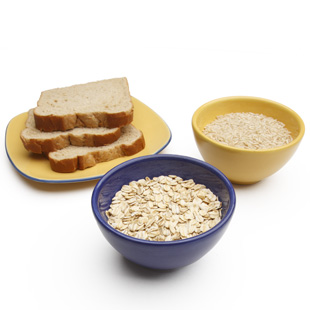5 Small Food Swaps To Make You Instantly Healthier

Here is some basic, simple nutrition advice to help you get healthier instantly.
For once, make achieving your “get healthy” resolution easy. No gimmicks, no big outlay of money or time. Just some simple everyday changes to have a happy and healthy new year!

Swap Out: Butter
Swap In: Olive or Canola Oil
Not all fat is bad. Opt for unsaturated (e.g., olive or canola oil) over saturated fats, such as butter. Here’s a nutrition breakdown: 1 tablespoon of olive oil has 14 grams fat, 2 of which are saturated; 1 tablespoon of canola oil has 14 grams fat, 1 gram saturated; 1 tablespoon butter has 11 grams fat, 7 of which are saturated. But because all fats are loaded with calories (119, 124 and 100 calories respectively), still use them in moderation.

Swap Out: Refined Grains
Swap In: Whole Grains
Refined carbohydrates, such as white bread and sugary sweets, may be just as bad for your heart and arteries as cream and butter—that’s one reason to limit them. But there are also reasons to pick whole grains over refined grains: people who eat plenty of whole grains tend to be leaner and have a lower risk of heart disease than those who don’t. What’s more, whole grains—like brown rice and bulgur—have their bran intact and thus have more fiber, B vitamins, magnesium, zinc and other nutrients.
Appealingly brown-colored bread or crackers labeled “multi-grain” or “cracked wheat” are sometimes made mostly from refined white flour. The only reliable guide to ensuring that your choice is a true whole grain is to check the ingredients list: the term “whole” or “whole-grain” should precede the grain's name, such as “whole-grain rye.”

Swap Out: Salt
Swap In: Fresh or Dried Herbs and Spices
Whether you have high blood pressure or not, it’s wise to watch your sodium intake. The USDA’s dietary guidelines for Americans recommend consuming less than 2,300 mg (about 1 teaspoon salt) daily. While not always a perfect replacement for salt, distracting your palate with chopped fresh or dried herbs and spices can help ease the transition to lower-salt cooking by waking up other flavors. Get creative with seasoning blends, found in any spice aisle; just make sure they’re labeled “salt-free.” Not ready to go salt-free? Get started with this easy tip: don’t add salt if you can’t taste it. A little salt goes a longer way if it’s sprinkled on a food just before serving; skip it while you’re cooking.

Swap Out: Full-Fat Dairy
Swap In: Low-Fat Dairy
Dairy products like milk, sour cream and yogurt are a good source of calcium—a bone-strengthening mineral most of us don’t get enough of. Choosing low-fat dairy products and nixing the full-fat versions is an easy way to cut saturated fat in your diet (saturated fat may boost risk of heart disease). Plus, recent research suggests that replacing full-fat dairy with low-fat dairy may also help lower blood pressure.

Swap Out: Steak
Swap In: Salmon
Yes, red meat is a great source of protein and iron (a mineral essential for getting oxygen from the lungs to cells throughout the body), but it’s also a big source of saturated fat in many people’s diets. You don’t have to give up your steak all the time, but trading one 3-ounce serving of steak for the same-size serving of salmon will save you about 8 grams of saturated fat. That serving of salmon also delivers heart-healthy omega-3 fats. (Omega-3s have also been linked with better eye health and hearing as you age and may even help boost your mood.)
Link http://www.eatingwell.com/nutrition_health/nutrition_news_information/5_small_food_swaps_to_make_you_instantly_healthier?

No comments:
Post a Comment